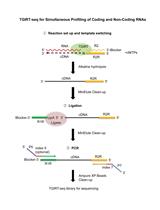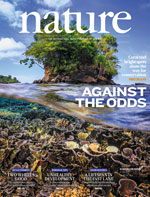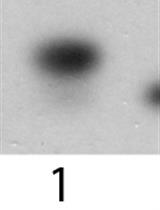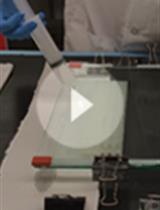- EN - English
- CN - 中文
RNA Capping by Transcription Initiation with Non-canonical Initiating Nucleotides (NCINs): Determination of Relative Efficiencies of Transcription Initiation with NCINs and NTPs
利用非典型启动核苷酸(NCIN)进行转录起始的RNA加帽:利用NCIN和NTP测定转录起始的相对效率
发布: 2017年06月20日第7卷第12期 DOI: 10.21769/BioProtoc.2336 浏览次数: 9246
评审: Gal HaimovichMelike ÇağlayanAnonymous reviewer(s)

相关实验方案

用于全面分析细胞、细胞外囊泡和血浆 RNA 中编码和非编码 RNA 生物型的 TGIRT-seq 方法
Hengyi Xu [...] Alan M. Lambowitz
2021年12月05日 7136 阅读
Abstract
It recently has been established that adenine-containing cofactors, including nicotinamide adenine dinucleotide (NAD+), reduced nicotinamide adenine dinucleotide (NADH), and 3’-desphospho-coenzyme A (dpCoA), can serve as ‘non-canonical initiating nucleotides’ (NCINs) for transcription initiation by bacterial and eukaryotic cellular RNA polymerases (RNAPs) and that the efficiency of the reaction is determined by promoter sequence (Bird et al., 2016). Here we describe a protocol to quantify the relative efficiencies of transcription initiation using an NCIN vs. transcription initiation using a nucleoside triphosphate (NTP) for a given promoter sequence.
Keywords: RNA polymerase (RNA聚合酶)Background
Transcription in bacteria, archaea, and eukaryotes is carried out by multi-subunit RNA polymerases (RNAPs) conserved in sequence, structure, and mechanism (Ebright, 2000; Lane and Darst, 2010). To initiate transcription, RNAP, together with one or more initiation factors, binds to a specific DNA sequence referred to as a ‘promoter’ and unwinds promoter DNA to form an RNAP-promoter open complex (RPo) containing an unwound ‘transcription bubble’ (Figure 1A; Ruff et al., 2015). RNAP then selects a transcription start site by expanding (‘scrunching’) or contracting (‘antiscrunching’) the transcription bubble to place transcription-start-site nucleotides in the RNAP active-center initiating site (‘i site’) and extending site (‘i+1 site’), binds a complementary initiating nucleotide substrate in the i site and a complementary extending substrate in the ‘i+1’ site, and catalyzes phosphodiester-bond formation to yield an initial RNA product (Winkelman et al., 2016).
In standard de novo transcription initiation, the initiating substrate is a nucleoside triphosphate (NTP), typically ATP or GTP (Nickels and Dove, 2011). However, recently it has been established that adenine-containing cofactors, including nicotinamide adenine dinucleotide (NAD+), reduced nicotinamide adenine dinucleotide (NADH), and 3’-desphospho-coenzyme A (dpCoA), can serve as alternative initiating substrates (‘non-canonical initiating nucleotides’; NCINs), yielding NCIN-capped RNA products that have distinctive 5’-end structures, stabilities, and translation efficiencies (Figures 1B-1C; Bird et al., 2016; Barvik et al., 2016; Jiao et al., 2017; Walters et al., 2017). It further has been established that the relative efficiencies of NCIN-mediated initiation vs. NTP-mediated initiation are determined by promoter sequence (Bird et al., 2016).
Here, we describe a protocol to determine the relative efficiencies of NCIN-mediated transcription initiation versus ATP-mediated transcription initiation, (kcat/KM, NCIN)/(kcat/KM, ATP), for a given promoter sequence. The protocol involves generating radiolabeled initial RNA products in a set of transcription reactions having a constant concentration of NCIN and varying concentrations of ATP, followed by quantifying NCIN-initiated RNA and total RNA, followed by plotting observed ratios of NCIN-initiated RNA to total RNA as a function of ratios of NCIN concentration to ATP concentration. 
Figure 1. Transcription initiation. A. RNAP-promoter open complex (RPo) with unwound transcription bubble. Gray, RNAP; blue, -10-element nucleotides; i and i+1, RNAP active-center initiating nucleotide binding site and extending nucleotide binding site; boxes, DNA nucleotides (nontemplate-strand nucleotides above template-strand nucleotides). B. Structures of ATP and NAD+, Red, identical atoms in ATP and NAD+; C. Initial RNA products formed in transcription initiation using ATP (top) or transcription initiation using NAD+ (bottom). Left subpanels show initiating ATP or NAD+ bound in i site; right subpanels show initial RNA products formed using CTP as extending nucleotide. Red boxes, adenosine and cytosine moieties of ATP, NAD+, and CTP; green boxes, nicotinamide-riboside moiety of NAD+.
Materials and Reagents
- E. coli RNA polymerase σ70 holoenzyme
Note: Prepared as in Mukhopadhyay et al. (2003) or purchased (New England Biolabs, catalog number: M0551S ) - E. coli RNA polymerase core enzyme
Note: Prepared as in Artsimovitch et al. (2003). - E. coli σ70
Note: Prepared as Marr and Roberts (1997); Perdue and Roberts (2010). - NAD+ (grade I, free acid) (Roche Molecular Systems, catalog number: 10127965001 )
- NADH (grade I, free acid) (Roche Molecular Systems, catalog number: 10107735001 )
- Phusion Flash HF master mix (Thermo Fisher Scientific, Thermo ScientificTM, catalog number: F548L )
Note: For generating transcription templates. - Oligodeoxyribonucleotides (template and primers) (Integrated DNA Technologies, www.IDTdna.com)
- QIAquick PCR purification kit (QIAGEN, catalog number: 28106 )
- TEMED (Avantor Performance Materials, J.T. Baker®, catalog number: 4098-01 )
- Ammonium persulfate (VWR, AMRESCO, catalog number: 97064-594 )
- GeneMate LE Quick-Dissolve agarose (BioExpress, catalog number: E-3119-500 )
- 3’-Desphosphocoenzyme A (Sigma-Aldrich, catalog number: D3385 )
- SequaGel sequencing system (National Diagnostics, catalog number: EC-833 )
- High purity rNTP set (ATP, UTP, GTP, CTP) (100 mM) (GE Healthcare, catalog number: 27-2025-01 )
- [α-32P]-CTP EasyTide (3,000 Ci/mmol) (250 μCi) (Perkin Elmer, catalog number: BLU508H250UC )
- Tris base (VWR, AMRESCO, catalog number: 97061-800 )
- Potassium chloride (KCl) (EMD Millipore, catalog number: PX1405-1 )
- Magnesium chloride hexahydrate (EMD Millipore, catalog number: 5980-500GM )
- EDTA disodium salt dyhydrate (1 kg) (VWR, AMRESCO, catalog number: 97061-018 )
- Dithiothreitol (DTT) (Gold Bio, catalog number: DTT50 )
- Bovine serum albumin (BSA) fraction V (Alfa Aesar, Affymetrix/USB, catalog number: J10857 )
- Sodium dodecylsulfate (SDS) (VWR, AMRESCO, catalog number: 97064-470 )
- Deionized formamide (EMD Millipore, catalog number: 4610-100ML )
- Xylene cyanol (Sigma-Aldrich, catalog number: X4126-10G )
- Bromophenol blue (EMD Millipore, catalog number: BX1410-7 )
- Amaranth red (Acros Organics, catalog number: AC15303-0250 )
- Boric acid (ACS grade) (VWR, AMRESCO, catalog number: 97061-980 )
- Sodium acetate, trihydrate (Avantor Performance Materials, MACRON, catalog number: 7364-06 )
- Hydrochloric acid (ACS plus) (Fisher Scientific, catalog number: A144-212 )
- Glycerol (ACS grade) (EMD Millipore, catalog number: GX0185-5 )
- Transcription buffer (1x) (see Recipes)
- Transcription buffer (5x) (see Recipes)
- Transcription stop buffer (see Recipes)
- Tris-borate EDTA buffer (TBE) (see Recipes)
- TBE + 0.3 M sodium acetate (see Recipes)
Equipment
- NanoDrop 2000c spectrophotometer ND2000C (Thermo Fisher Scientific, Thermo ScientificTM, model: NanoDropTM 2000/2000c , catalog number: ND-2000C)
- Glass plate
- Block digital heater w/20 tapered hole blocks (VWR, catalog numbers: 12621-088 ; 13259-002 )
- 5424 table top centrifuge with w/FA-45-24-11 rotor (Eppendorf, mdoel: 5424/5424 R , catalog number: 5424000410)
- Powerpack HV powersupply (Bio-Rad Laboratories, model: PowerPac HV Power Supply, catalog number: 1645056 )
- Sequi-gen GT sequencing gel system (38 x 30 cm gel) (Bio-Rad Laboratories, catalog number: 1653862 )
Note: This product has been discontinued. - Hydrotech vacuum pump (Bio-Rad Laboratories, catalog number: 1651781 )
- Model 583 gel dryer (Bio-Rad Laboratories, model: Model 583, catalog number: 1651745 )
- DNA Engine Dyad PCR Machine 4 x 48 well blocks (Bio-Rad Laboratories)
- Unmounted phosphor exposure screen (35 x 43 cm) (GE Healthcare, model: General Purpose Screens, catalog number: 63-0034-79 )
- Storm 840 scanner (Molecular Dynamics, model: Storm 840 )
- Windows computer (HP, model: Compaq dc7700 )
Software
- Excel (Microsoft)
- ImageQuant (GE)
- SigmaPlot (Systat)
Procedure
文章信息
版权信息
© 2017 The Authors; exclusive licensee Bio-protocol LLC.
如何引用
Bird, J. G., Nickels, B. E. and Ebright, R. H. (2017). RNA Capping by Transcription Initiation with Non-canonical Initiating Nucleotides (NCINs): Determination of Relative Efficiencies of Transcription Initiation with NCINs and NTPs. Bio-protocol 7(12): e2336. DOI: 10.21769/BioProtoc.2336.
分类
微生物学 > 微生物生物化学 > RNA
分子生物学 > RNA > 转录
您对这篇实验方法有问题吗?
在此处发布您的问题,我们将邀请本文作者来回答。同时,我们会将您的问题发布到Bio-protocol Exchange,以便寻求社区成员的帮助。
Share
Bluesky
X
Copy link











